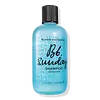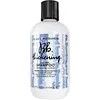What's inside
What's inside
 Key Ingredients
Key Ingredients

No key ingredients
 Benefits
Benefits

 Concerns
Concerns

 Ingredients Side-by-side
Ingredients Side-by-side

Water
Skin ConditioningSodium Laureth Sulfate
CleansingCocamidopropyl Betaine
CleansingPPG-2 Hydroxyethyl Cocamide
EmulsifyingPanax Ginseng Root Extract
EmollientRosmarinus Officinalis Leaf Extract
AntimicrobialSalvia Officinalis Leaf Extract
CleansingIsoceteth-20
EmulsifyingSodium Chloride
MaskingGlycerin
HumectantTetrasodium EDTA
Citric Acid
BufferingChlorphenesin
AntimicrobialPhenoxyethanol
PreservativeMethylchloroisothiazolinone
PreservativeMethylisothiazolinone
PreservativeCI 61570
Cosmetic ColorantCI 60730
Cosmetic ColorantLimonene
PerfumingParfum
MaskingWater, Sodium Laureth Sulfate, Cocamidopropyl Betaine, PPG-2 Hydroxyethyl Cocamide, Panax Ginseng Root Extract, Rosmarinus Officinalis Leaf Extract, Salvia Officinalis Leaf Extract, Isoceteth-20, Sodium Chloride, Glycerin, Tetrasodium EDTA, Citric Acid, Chlorphenesin, Phenoxyethanol, Methylchloroisothiazolinone, Methylisothiazolinone, CI 61570, CI 60730, Limonene, Parfum
Water
Skin ConditioningCetearyl Alcohol
EmollientStearamidopropyl Dimethylamine
EmulsifyingBehentrimonium Chloride
PreservativeCetyl Alcohol
EmollientIsododecane
EmollientStearyl Alcohol
EmollientPhyllanthus Emblica Fruit Extract
HumectantOryza Sativa Seed Protein
AntioxidantHydrolyzed Yeast Protein
Skin ConditioningHydrolyzed Corn Protein
Skin ConditioningOryza Sativa Bran Extract
Skin ConditioningOryza Sativa Extract
AbsorbentPisum Sativum Extract
Skin ConditioningRosmarinus Officinalis Leaf Extract
AntimicrobialHelianthus Annuus Extract
EmollientOcimum Basilicum Hairy Root Culture Extract
Skin ConditioningLaurdimonium Hydroxypropyl Hydrolyzed Keratin
Skin ConditioningHelianthus Annuus Seed Oil
EmollientCocos Nucifera Oil
MaskingHydrogenated Ethylhexyl Olivate
EmollientCaprylyl Glycol
EmollientCetrimonium Chloride
AntimicrobialHydroxyethylcellulose
Emulsion StabilisingEthylhexylglycerin
Skin ConditioningAmodimethicone
Propanediol
SolventGuar Hydroxypropyltrimonium Chloride
Skin ConditioningPolysorbate 60
EmulsifyingIsopropyl Alcohol
SolventMethoxy PEG/PPG-7/3 Aminopropyl Dimethicone
Panthenol
Skin ConditioningC11-15 Pareth-7
EmulsifyingPolysilicone-12
Pentaerythrityl Tetra-Di-T-Butyl Hydroxyhydrocinnamate
AntioxidantHydrogenated Olive Oil Unsaponifiables
EmollientCyperus Esculentus Root Oil
MaskingGlycerin
HumectantTrideceth-12
EmulsifyingOctyldodecanol
EmollientAlcohol
AntimicrobialLaureth-9
EmulsifyingTocopherol
AntioxidantVp/Hexadecene Copolymer
Cystine Bis-Pg-Propyl Silanetriol
Skin ConditioningJojoba Esters
EmollientBHT
AntioxidantCitric Acid
BufferingParfum
MaskingLinalool
PerfumingBenzyl Benzoate
AntimicrobialLimonene
PerfumingHexyl Cinnamal
PerfumingButylphenyl Methylpropional
PerfumingPhytic Acid
Disodium EDTA
Phenoxyethanol
PreservativeSorbic Acid
PreservativeChlorphenesin
AntimicrobialSodium Benzoate
MaskingWater, Cetearyl Alcohol, Stearamidopropyl Dimethylamine, Behentrimonium Chloride, Cetyl Alcohol, Isododecane, Stearyl Alcohol, Phyllanthus Emblica Fruit Extract, Oryza Sativa Seed Protein, Hydrolyzed Yeast Protein, Hydrolyzed Corn Protein, Oryza Sativa Bran Extract, Oryza Sativa Extract, Pisum Sativum Extract, Rosmarinus Officinalis Leaf Extract, Helianthus Annuus Extract, Ocimum Basilicum Hairy Root Culture Extract, Laurdimonium Hydroxypropyl Hydrolyzed Keratin, Helianthus Annuus Seed Oil, Cocos Nucifera Oil, Hydrogenated Ethylhexyl Olivate, Caprylyl Glycol, Cetrimonium Chloride, Hydroxyethylcellulose, Ethylhexylglycerin, Amodimethicone, Propanediol, Guar Hydroxypropyltrimonium Chloride, Polysorbate 60, Isopropyl Alcohol, Methoxy PEG/PPG-7/3 Aminopropyl Dimethicone, Panthenol, C11-15 Pareth-7, Polysilicone-12, Pentaerythrityl Tetra-Di-T-Butyl Hydroxyhydrocinnamate, Hydrogenated Olive Oil Unsaponifiables, Cyperus Esculentus Root Oil, Glycerin, Trideceth-12, Octyldodecanol, Alcohol, Laureth-9, Tocopherol, Vp/Hexadecene Copolymer, Cystine Bis-Pg-Propyl Silanetriol, Jojoba Esters, BHT, Citric Acid, Parfum, Linalool, Benzyl Benzoate, Limonene, Hexyl Cinnamal, Butylphenyl Methylpropional, Phytic Acid, Disodium EDTA, Phenoxyethanol, Sorbic Acid, Chlorphenesin, Sodium Benzoate
 Reviews
Reviews

Ingredients Explained
These ingredients are found in both products.
Ingredients higher up in an ingredient list are typically present in a larger amount.
Chlorphenesin is a synthetic preservative. It helps protect a product against bacteria in order to extend shelf life. In most cases, Chlorphenesin is paired with other preservatives such as phenoxyethanol and caprylyl glycol.
Chlorphenesin is a biocide. This means it is able to help fight the microorganisms on our skin. It is also able to fight odor-releasing bacteria.
Chlorphenesin is soluble in both water and glycerin.
Studies show Chlorphenesin is easily absorbed by our skin. You should speak with a skincare professional if you have concerns about using Chlorphenesin.
Learn more about ChlorphenesinCitric Acid is an alpha hydroxy acid (AHA) naturally found in citrus fruits like oranges, lemons, and limes.
Like other AHAs, citric acid can exfoliate skin by breaking down the bonds that hold dead skin cells together. This helps reveal smoother and brighter skin underneath.
However, this exfoliating effect only happens at high concentrations (20%) which can be hard to find in cosmetic products.
Due to this, citric acid is usually included in small amounts as a pH adjuster. This helps keep products slightly more acidic and compatible with skin's natural pH.
In skincare formulas, citric acid can:
While it can provide some skin benefits, research shows lactic acid and glycolic acid are generally more effective and less irritating exfoliants.
Most citric acid used in skincare today is made by fermenting sugars (usually from molasses). This synthetic version is identical to the natural citrus form but easier to stabilize and use in formulations.
Read more about some other popular AHA's here:
Learn more about Citric AcidGlycerin is already naturally found in your skin. It helps moisturize and protect your skin.
A study from 2016 found glycerin to be more effective as a humectant than AHAs and hyaluronic acid.
As a humectant, it helps the skin stay hydrated by pulling moisture to your skin. The low molecular weight of glycerin allows it to pull moisture into the deeper layers of your skin.
Hydrated skin improves your skin barrier; Your skin barrier helps protect against irritants and bacteria.
Glycerin has also been found to have antimicrobial and antiviral properties. Due to these properties, glycerin is often used in wound and burn treatments.
In cosmetics, glycerin is usually derived from plants such as soybean or palm. However, it can also be sourced from animals, such as tallow or animal fat.
This ingredient is organic, colorless, odorless, and non-toxic.
Glycerin is the name for this ingredient in American English. British English uses Glycerol/Glycerine.
Learn more about GlycerinLimonene is a fragrance that adds scent and taste to a formulation.
It's found in the peel oil of citrus fruits and other plants such as lavender and eucalyptus. The scent of limonene is generally described as "sweet citrus".
Limonene acts as an antioxidant, meaning it helps neutralize free radicals.
When exposed to air, oxidized limonene may sensitize the skin. Because of this, limonene is often avoided by people with sensitive skin.
The term 'fragrance' is not regulated in many countries. In many cases, it is up to the brand to define this term. For instance, many brands choose to label themselves as "fragrance-free" because they are not using synthetic fragrances. However, their products may still contain ingredients such as essential oils that are considered a fragrance.
Learn more about LimoneneParfum is a catch-all term for an ingredient or more that is used to give a scent to products.
Also called "fragrance", this ingredient can be a blend of hundreds of chemicals or plant oils. This means every product with "fragrance" or "parfum" in the ingredients list is a different mixture.
For instance, Habanolide is a proprietary trade name for a specific aroma chemical. When used as a fragrance ingredient in cosmetics, most aroma chemicals fall under the broad labeling category of “FRAGRANCE” or “PARFUM” according to EU and US regulations.
The term 'parfum' or 'fragrance' is not regulated in many countries. In many cases, it is up to the brand to define this term.
For instance, many brands choose to label themselves as "fragrance-free" because they are not using synthetic fragrances. However, their products may still contain ingredients such as essential oils that are considered a fragrance by INCI standards.
One example is Calendula flower extract. Calendula is an essential oil that still imparts a scent or 'fragrance'.
Depending on the blend, the ingredients in the mixture can cause allergies and sensitivities on the skin. Some ingredients that are known EU allergens include linalool and citronellol.
Parfum can also be used to mask or cover an unpleasant scent.
The bottom line is: not all fragrances/parfum/ingredients are created equally. If you are worried about fragrances, we recommend taking a closer look at an ingredient. And of course, we always recommend speaking with a professional.
Learn more about ParfumPhenoxyethanol is a preservative that has germicide, antimicrobial, and aromatic properties. Studies show that phenoxyethanol can prevent microbial growth. By itself, it has a scent that is similar to that of a rose.
It's often used in formulations along with Caprylyl Glycol to preserve the shelf life of products.
Rosmarinus Officinalis Leaf Extract comes from rosemary. Rosemary is native to the Mediterranean.
While Rosmarinus Officinalis Leaf Oil can be volatile due to its fragrant properties, the fragrance components are usually removed in the leaf extract.
Rosemary Leaf Extract contains many antioxidants such as rosmarinic acid and caffeic acid. Rosemarinic acid, a compound found in rosemary leaf, has been found to help soothe skin conditions such as eczema and acne.
Learn more about Rosmarinus Officinalis Leaf ExtractWater. It's the most common cosmetic ingredient of all. You'll usually see it at the top of ingredient lists, meaning that it makes up the largest part of the product.
So why is it so popular? Water most often acts as a solvent - this means that it helps dissolve other ingredients into the formulation.
You'll also recognize water as that liquid we all need to stay alive. If you see this, drink a glass of water. Stay hydrated!
Learn more about Water